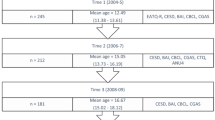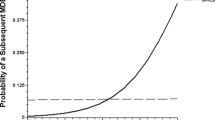Abstract
A 6-year longitudinal panel study investigated the absolute and relative stability in depressed mood throughout adolescence by reporting data from a sample of 538 adolescents between 13 and 19 years of age. Results revealed the following. (1) Girls had on average higher depressed mood scores than boys at all ages. (2) Among boys there were no substantial changes in depressed mood mean scores, while among girls there was a slight tendency of a curvilinear trend, with a peak level reached in midadolescence. (3) There was a tendency for adolescents to retain their relative level in depressed mood, most pronounced for a period of 4 years, from age 15 to age 19 years. (4) Depressed mood was most stable in a subgroup of adolescents who had high initial depressed mood scores. (5) By applying structural equation modeling, it was shown that the stable (“trait”) component of depressed mood increased in importance with increasing age, while the temporal (“state”) component decreased with increased age.
Similar content being viewed by others
REFERENCES
Alsaker, F. D., and Olweus, D. (1992). Stability of global self-evaluations in early adolescence: A cohort longitudinal study. J. Res. Adolesc. 2: 123–145.
Alsaker, F. D., Dundas, I., and Olweus, D. (1991). A growth curve approach to the study of parental relations and depression in adolescence. Paper presented in Seattle, April.
Bentler, P. (1995). EQS Structural Equations Program Manual, Multivariate Software, Encino, CA.
Bentler, P. M., and Bonett, D. G. (1980). Significance tests and goodness-of-fit in the analysis of covariance structures. Psychol. Bull. 88: 588–606.
Bergman, L. R., Eklund, G., and Magnusson, D. (1989). Studying individual development: Problems and methods. In Magnusson, D., Bergman, L. R., Rudinger, G., and Torestad, B. (eds.), Problems and Methods in Longitudinal Research. Stability and Change, Cambridge University Press, Cambridge.
Bjerke, T. (1992). Selvmord og selvmordsforsø k blant unge, Tapir, Trondheim.
Carlson, G. A., and Cantwell, D. P. (1980). A survey of depressive symptoms, syndrome and disorder in a child psychiatric population. J. Child Psychol. Psychiatry 21: 19–25.
Charman, T. (1994). The stability of depressed mood in young adolescents: A school-based survey. J. Affect. Disorder 30: 109–116.
Cohen, P., Cohen, J., Teresi, J., Marchi, M., and Velez, C. N. (1990). Problems in the measurement of latent variables in structural equations causal models. Appl. Psychol. Measure. 14(2): 183–196.
Cole, D. A. (1989). Psychopathology of adolescent suicide: Hopelessness, coping beliefs, and depression. J. Abnorm. Psychol. 98(3): 248–255.
Compas, B. E. (1993). Promoting positive mental health during adolescence. In Millstein, S. G., Petersen, A. C., and Nightingale, E. O. (eds.), Promoting the Health of Adolescents, NewDirections for the Twenty-First Century, Oxford University Press, New York.
Compas, B. E., Ey, S., and Grant, K. E. (1993). Taxonomy, assessment, and depression during adolescence. Psychol. Bull. 114(2): 323–344.
Cortina, J. M. (1993). What is coefficient alpha? An examination of theory and applications. J. Appl. Psychol. 78(1): 98–104.
Cronbach, L. J. (1970). Essentials of Psychological Testing, Harper & Row, New York.
Cytryn, L., and McKnew, D. H. (1974). Factors influencing the changing clinical expression of the depressive process in children. Am. J. Psychiatry 131: 879–881.
Devine, D., Kempton, T., and Forehand, R. (1994). Adolescent depressed mood and young adult functioning: A longitudinal study. J. Abnorm. Child Psychol. 22(5): 629–641.
Dumenci, L., and Windle, M. (1996). A latent trait-state model of adolescent depression using the Center for Epidemiological Studies Depression Scale. Multivar. Behav. Res. 31(3): 313–330.
Garrison, C. Z., Jackson, A. B., Marsteller, F., McKeown, R., and Addy, C. (1990). A longitudinal study of depressive symptomatology in young adolescents. Am. Acad. Child Adolesc. Psychiatry 29(4): 581–586.
Gjerde, P. F. (1993). Depressive symptoms in young adults: A developmental perspective on gender differences. In Funder, D., Parke, R. D., Tomlinson-Keasey, C., and Widamanwash, D. C. (eds.), Studying Lives Through Time. Personality and Development, APA, Washington, DC.
Harrington, R. (1993). Depressive Disorder in Childhood and Adolescence,Wiley & Sons, Chichester, England.
Hayduk, L. A. (1996). LISREL. Issues, Debates, and Strategies, The John Hopkins University Press, London.
Kandel, D. B., and Davies, M. (1982). Epidemiology of depressive mood in adolescents. Arch. Gen. Psychiatry 39: 1205–1212.
Kandel, D. B., and Davies, M. (1986). Adult sequelae of adolescent depressive symptom. Arch. Gen. Psychiatry 43: 255–262.
Kandel, D. B., Raveis, V. H., and Davies, M. (1991). Suicidal ideation in adolescence: Depression, substance use, and other risk factors. J. Youth Adolesc. 20: 289–309.
Lange, J. (1991). Depresjon hos barn og unge—et osynliggjort fenomen. Nordisk Med. 106: 84–85.
Lewinsohn, P. M., Hobermann, H., and Rosenbaum, M. (1988). A prospective study for risk factors for unipolar depression. J. Abnorm. Psychol. 97: 251–264.
Lewinsohn, P. M., Gotlieb, I. H., and Seeley, J. R. (1997). Depression-related psychosocial variables: Are they specific to depression in adolescents? J. Abnorm. Psychol. 106(3): 365–375.
MacCallum, R. C., and Browne, M. (1993). The use of causal indicators in covariance structure models: Some practical issues. Psychol. Bull. 114(3): 533–541.
Marsh, H. W., and Grayson, D. (1994). Longitudinal confirmatory factor analysis: Common, timespecific, item-specific, and residual-error components of variance. Struct. Eq. Model. 1(2): 116–145.
McConville, C., and Cooper, C. (1992). The structure of moods. Person. Indiv. Diff. 13(8): 909–919.
Merikangas, K. R., and Angst, J. (1995). The challenge of depressive disorders in adolescence. In Rutter, M. (ed.), Psychosocial Disturbances in Young People, Challenges for Prevention, Cambridge University Press, New York.
Miller, M. B. (1995). Coefficient alpha: A basic introduction from the perspectives of classical test theory and structural equation modelling. Struct. Eq. Model. 2(3): 255–273.
Nolen-Hoeksema, S. (1991). Responses to depression and their effects on the duration of depressive episodes. J. Abnorm. Psychol. 100: 569–582.
Nolen-Hoeksema, S. (1994). Aninteractive model for the emergence of gender differences in depression in adolescence. J. Res. Adolesc. 4: 519–534.
Nolen-Hoeksema, S., and Girgus, J. S. (1994). The emergence of gender differences in depression during adolescence. Psychol. Bull. 115(3): 424–443.
Nolen-Hoeksema, S., Girgus, J. S., and Seligman (1992). Predictors and consequences of childhood depressive symptoms: A five year longitudinal study. J. Abnorm. Psychol. 101: 405–422.
Offer, D., and Schanert-Reichel, K. A. (1992). Debunking the myths of adolescence: Findings from recent research. J. Am. Acad. Child Adolesc. 31: 1003–1014.
Petersen, A. C., Sarigiani, P. A., and Kennedy, R. E. (1991). Adolescent depression: Why more girls? J. Youth Adolesc. 20: 247–272.
Petersen, A. C., Compas, B. E., Brooks-Gunn, J., Stemmler, M., Ey, S., and Grant, K. E. (1993). Depression in adolescence. Am. Psychol. 48(2): 155–168.
Radloff, L. (1977). The CES-D scale: A self-report depression scale for research in the general population. Appl. Psychosoc. Measure. 1: 385–401.
Radloff, L. S. (1991). The use of the Center for Epidemiological Studies Depression Scale in adolescents and adults (Special Issue: The emergence of depressive symptoms during adolescence). J. Youth Adolesc. 20: 149–166.
Reinherz, H. Z., Giaconia, R. M., Pakiz, B., Silverman, A. M., Frost, A. K., and Lefkowitz, E. S. (1993). Psychosocial risks for major depression in late adolescence: A longitudinal community study. J. Am. Acad. Child Adolesc. Psychiatry 32(6): 1155–1164.
Rutter, M. (1987). Psychosocial resilience and protective mechanisms. Am. J. Orthopsychiatry 57(3): 316–332.
Rutter, M., Graham, P., Chadwick, O. F. D., and Yule, W. (1976). Adolescent turmoil: Fact or fiction? J. Child Psychol. Psychiatry 17: 35–57.
Schmitt, M. J., and Steyer, R. (1993). A latent trait-state model (not only) for social desiranility. Person. and Indiv. Diff. 14: 519–529.
Sheehan, T. J., Fitfield, J., Reisine, S., and Tennan, H. (1995). The measurement structure of the Center for Epidemiological Studies Depression Scale. J. Person. Assess. 64(3): 507–521.
Author information
Authors and Affiliations
Rights and permissions
About this article
Cite this article
Holsen, I., Kraft, P. & Vittersø, J. Stability in Depressed Mood in Adolescence: Results from a 6-Year Longitudinal Panel Study. Journal of Youth and Adolescence 29, 61–78 (2000). https://doi.org/10.1023/A:1005121121721
Issue Date:
DOI: https://doi.org/10.1023/A:1005121121721




